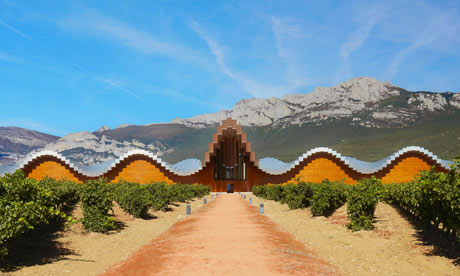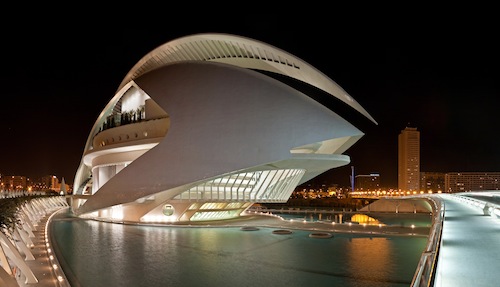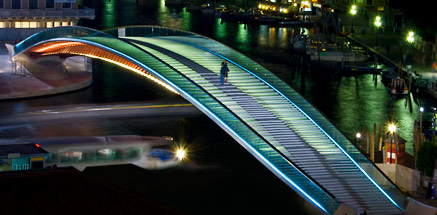He is the genius behind some of the world's most spectacular bridges, museums and airports, but Spanish architect Santiago Calatrava cannot plug a leaking roof, according to a client who is demanding he contribute to the €2m (£1.7m) needed to pay someone else to do the job. A dozen years after Calatrava built the spectacular Ysios winery in the rainy Alava region of northern Spain, the building's dramatic, undulating roof continues to let in the damp.
Now Domecq, the owner of the winery, has said it is fed up with the botched attempts of Calatrava's original builders at fixing the roof and wants money from them so that it can bring in fresh architects and engineers to design a new one.
An expert's report that accompanies a writ lodged at a court in Vitoria claims that the roof, made of wood and aluminium, has never managed to keep the rain out. The firm pledges to maintain the original outline designed by Calatrava – an architect and engineer sometimes compared with fellow Spaniard Antoni Gaudí – but says that the leaks are damaging its image.
The row comes on the top of complaints in Calatrava's home city of Valencia about the slowly wrinkling, ceramic outer skin of the city's emblematic Palau de Les Arts, where tiles have started to shake loose.
Opposition politicians in Valencia claim that the overall budget for his spaceship-like arts and science complex in the city has quadrupled to €1bn – with almost €100m for the architect's firm. They have demanded that Zurich-based Calatrava, who responded that "his honour was wounded", give some of the money back.
"It has not just put Valencia on the map, but is the second-most visited cultural centre in Spain, after the Alhambra," the architect once declared.
He is also on record as saying that his fees for various projects in the city were perfectly reasonable.
Yet another row, this time with Italian authorities, has seen doubts raised about the cost of his bridge over the Grand Canal in Venice – the first bridge to be built there in 75 years. Authorities now demand that he and others involved cover some €4m of spending, while Il Giornale newspaper recently claimed the city had received some 5,000 complaints from those who have used it, including some who also claim it is too slippery.
In northern Bilbao, meanwhile, his Zubizuri bridge over the river Nervión has been dubbed the "wipe-out" bridge, because of the number of people who have slipped and fallen. Authorities there have also reportedly had to spend up to €6,000 a year replacing broken tiles.
The mayor of Bilbao, Iñaki Azkuna, who lost a case against him after authorities altered the original design of his bridge, once declared: "I'm fed up with the dictatorship of Calatrava." In Oviedo a court has ordered that the architect and construction firms involved in building a conference hall there should pay €3m to the insurance firm after part of the structure collapsed during building.
The Oviedo hall's infamous, huge mechanical visor has never worked because of problems with its hydraulics. Calatrava is currently battling the building's owners through the courts after they blamed him and refused to pay his full fees.
But for every Calatrava building that gets into trouble, there are several that survive without creating polemic. They include two bridges in Dublin and Manchester, railway stations in Lisbon, Liege and Lyon and buildings in New York and Milwaukee.
Calatrava did not respond to questions sent to his Zurich office.
Related Stories
| Aug 11, 2010
'Flexible' building designed to physically respond to the environment
The ecoFLEX project, designed by a team from Shepley Bulfinch, has won a prestigious 2009 Unbuilt Architecture Design Award from the Boston Society of Architects. EcoFLEX features heat-sensitive assemblies composed of a series of bi-material strips. The assemblies’ form modulate with the temperature to create varying levels of shading and wind shielding, flexing when heated to block sunlight and contracting when cooled to allow breezes to pass through the screen.
| Aug 11, 2010
New book provides energy efficiency guidance for hotels
Recommendations on achieving 30% energy savings over minimum code requirements are contained in the newly published Advanced Energy Design Guide for Highway Lodging. The energy savings guidance for design of new hotels provides a first step toward achieving a net-zero-energy building.
| Aug 11, 2010
Perkins+Will master plans Vedanta University teaching hospital in India
Working together with the Anil Agarwal Foundation, Perkins+Will developed the master plan for the Medical Precinct of a new teaching hospital in a remote section of Puri, Orissa, India. The hospital is part of an ambitious plan to develop this rural area into a global center of education and healthcare that would be on par with Harvard, Stanford, and Oxford.
| Aug 11, 2010
Burt Hill, HOK top BD+C's ranking of the nation's 100 largest university design firms
A ranking of the Top 100 University Design Firms based on Building Design+Construction's 2009 Giants 300 survey. For more Giants 300 rankings, visit http://www.BDCnetwork.com/Giants
| Aug 11, 2010
PBK, DLR Group among nation's largest K-12 school design firms, according to BD+C's Giants 300 report
A ranking of the Top 75 K-12 School Design Firms based on Building Design+Construction's 2009 Giants 300 survey. For more Giants 300 rankings, visit http://www.BDCnetwork.com/Giants
| Aug 11, 2010
Turner Building Cost Index dips nearly 4% in second quarter 2009
Turner Construction Company announced that the second quarter 2009 Turner Building Cost Index, which measures nonresidential building construction costs in the U.S., has decreased 3.35% from the first quarter 2009 and is 8.92% lower than its peak in the second quarter of 2008. The Turner Building Cost Index number for second quarter 2009 is 837.










